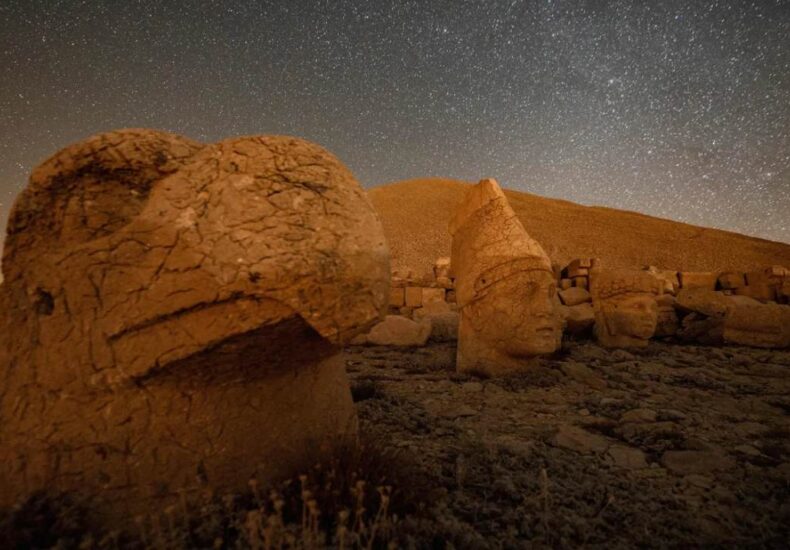
Mount Nemrut: Where Colossal Stone Gods Guard a 2,000-Year-Old Mystery
Fundacion Rapala – Mount Nemrut rises quietly above Adıyaman, its rocky slopes blending into the Taurus range. From a distance, it looks like any other mountain. But as travelers climb higher, the surprise appears: a line of giant stone heads near the summit. Their calm expressions, worn by wind and frost, seem to watch the landscape in silence. The air feels colder, and the wind grows stronger, adding a sense of mystery to the scene. Many visitors describe the moment as stepping into another world. These ancient faces carry stories of kings, gods, and forgotten kingdoms. Standing before them, it becomes clear why Nemrut remains one of Turkey’s most unforgettable sites.
The Kingdom of Commagene and Its Ambitious Ruler
Two thousand years ago, Nemrut belonged to the Kingdom of Commagene. Its ruler, King Antiochus I, wanted to unite Greek, Persian, Armenian, and local cultures into one powerful identity. To show this vision, he built a massive sanctuary on Mount Nemrut. He placed statues of Zeus, Apollo, Heracles, and a fertility goddess around his tomb. He even sat himself among them, hoping his name would live forever. Although earthquakes toppled many statues, their presence still speaks loudly about Antiochus’s bold dreams. Each carved face shows the kingdom’s unique mix of beliefs, symbols, and artistic styles that shaped its identity.
A Journey Through Villages, Valleys, and Ancient Roads
Getting to Nemrut feels like traveling through time. The road from Kahta winds through quiet farms where goats graze and villagers work fields as they have for centuries. Stone houses line the hills, and locals often greet visitors with warm smiles. As travelers climb higher, ancient landmarks appear one by one. The Roman-built Septimius Severus Bridge still stands strong over the Cendere River. Nearby, the Karakuş Tumulus honors royal women, while the Arsemia ruins reveal carvings and inscriptions from Commagene’s rulers. Each stop offers clues about the region’s long history. By the time visitors reach the upper roads, the past feels very close ready to reveal its secrets at the summit.
“Read More : Singapore PM Meets East Java Governor Khofifah to Boost Investment Cooperation”
The Final Climb Toward the Throne of the Gods
Visitors begin the last stretch at the entrance to Mount Nemrut National Park. After paying the gate fee, they start a steep 25-minute climb. The air cools with every step, and rocky paths demand steady footing. Soon a huge mound appears at the top: a 50-meter-high tumulus built from small stones. Many believe King Antiochus lies hidden beneath this structure. As travelers approach the summit, the mountain opens into three terraces filled with ancient statues. The setting feels sacred. The wind moves strongly across the stones. The sky seems wider. When the colossal figures finally come into view, most visitors pause, breathless not from the climb, but from awe.
The Mystery of Antiochus I’s Hidden Tomb
The true resting place of Antiochus I remains one of archaeology’s biggest mysteries. A German engineer first reported Mount Nemrut in 1881. His discovery attracted scholars from across Europe and America. Among them was American archaeologist Theresa Goell, who dedicated decades to finding the king’s burial chamber. She dug tunnels and studied the mountain’s structure but never reached the tomb. Some experts believe the interior design may resemble Egypt’s pyramids, with hidden chambers hard to penetrate. Today, modern researchers use ground scanners to study the tumulus. But Turkish law forbids digging, so the mystery stays alive. The hidden chamber remains untouched, protected by stone, time, and the mountain itself.
A Sacred Stage Where Gods, Heroes, and Kings Meet
The summit contains three terraces: East, West, and North. The East Terrace features five giant seated figures Zeus, Apollo, Heracles, Commagene’s goddess, and Antiochus. Lions and eagles stand beside them, symbolizing earthly and heavenly power. The West Terrace presents the most famous scene: the fallen heads resting on the ground, glowing orange during sunset. The North Terrace, left unfinished in ancient times, adds another layer of mystery. Walking through these terraces feels like standing inside an open-air temple. The silence is deep, broken only by the wind. Visitors often describe the experience as emotional, as if stepping into a forgotten ritual.
Preserving a Monument That Defies Time
Mount Nemrut is now a protected national park and UNESCO World Heritage Site. Turkish conservators work carefully to protect the statues from harsh winters and strong winds. They use gentle techniques such as nano-lime injections to strengthen cracks without changing the stone’s appearance. Visitors are guided to follow marked paths and avoid touching the sculptures. This protection keeps the mountain safe for future generations. During sunrise and sunset, the light turns the statues golden, creating an unforgettable scene. In those moments, the mountain feels alive. It becomes clear why Nemrut continues to capture the world’s imagination its mystery, beauty, and history blend into one powerful story.